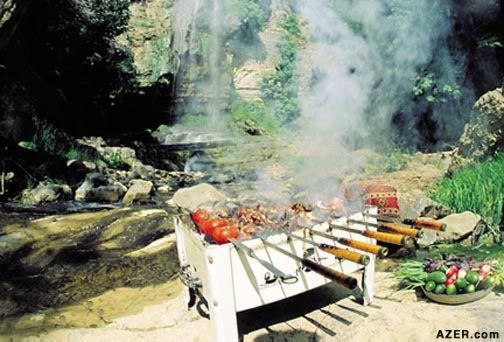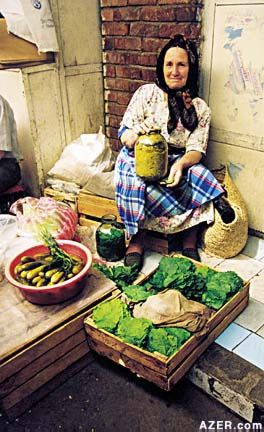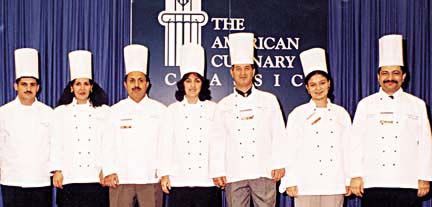|

Autumn 2000 (8.3)
Pages
16-19
From Pilaf to Pizza
A Road
Map of Azerbaiijani Cuisine
by
Tahir Amiraslanov

Above:
Making kabab
on a "mangal" grill. Photo: Huseinzade
"What is Azerbaijani cuisine?" This is the question
that has come up repeatedly as we worked on this issue. Does
it include the foods that Azerbaijanis ate before the Soviets
came to power? Today, many of those dishes are no longer prepared
in the Republic, or they're only eaten on occasion, like rice
pilaf. Or is Azerbaijani cuisine based on the foods that Azerbaijanis
ate during the Soviet period? Many of these dishes, like cabbage
dolma, are Russian or Russian-influenced. What foods can Azerbaijanis
claim as their own?
One thing is for sure: Azerbaijani cuisine has changed dramatically
over the past century due to political and economic influences
that were often beyond the control of Azerbaijanis themselves.
And this dynamic process is still very much alive today. Food
expert Tahir Amiraslanov discusses some of these past and present
changes, explaining some of the evolution that is taking place
in Azerbaijani cuisine.
During the Soviet period, Azerbaijan's state employees and students
ate in free, government-run cafeterias. Nutritious meals were
prepared every day, freeing Azerbaijani women from housework
by enabling them to spend less time cooking for their families.
In general the dishes that were prepared were the same in cafeterias
throughout the Soviet Union: meat cutlets, goulash, borscht and
shi (fish soup), plus a few national dishes. Such standardization
was one of the ways that the Soviet government set out to create
one Soviet people.
The phrase "you are what you eat" rings true, since
food is an important part of one's culture and sense of nationality.
The Soviet leaders were determined to shape the psychology and
behavior of all Soviet citizens in order to create the new Soviet
man. Therefore, basically the same food was served to all of
them. Primarily, it was created on the basis of Russian cuisine.
_____
Russian Influence
As a result, Azerbaijani cuisine underwent considerable changes
during the Soviet period, and a number of Russian dishes were
included as everyday fare. For instance, in pre-Soviet Azerbaijan,
we didn't have the Russian "Stolichniy" salad (potato
salad with shredded chicken, carrots and peas in a mayonnaise
base). We also didn't have the Russian salad vinegret (beans,
potatoes, carrots, pickled cabbage and beets). But now we have
accepted these salads and consider them our own, even to the
extent that we serve them at wedding parties and other special
occasions.
Prior to the Soviet period, alcohol was not usually served at
Azerbaijani wedding parties. But because of the Russian influence
and the decrease of Islam's significance during the Soviet period,
alcohol became the norm, especially at wedding parties - at least
among men. Also, we Azerbaijanis are now more likely to follow
the Russian pattern of serving cake for dessert (or ice cream,
too, as in the West), rather than our own national pastries like
shakarbura or pakhlava (baklava).
  Today, we no longer
have a system that provides free food to employees and students.
Most large factories have closed down and because wages are low,
most people can't afford to eat in restaurants. Along with independence
came bread lines - especially during the early years of our freedom
in the 1990s. You can't blame the Soviet Union, as this was a
phenomenon characteristic of the post-Soviet period and was experienced
throughout all of the 15 former republics. During the Soviet
period, commodities were much cheaper. A monthly salary was sufficient
to support a family and even entertain guests. Today, we no longer
have a system that provides free food to employees and students.
Most large factories have closed down and because wages are low,
most people can't afford to eat in restaurants. Along with independence
came bread lines - especially during the early years of our freedom
in the 1990s. You can't blame the Soviet Union, as this was a
phenomenon characteristic of the post-Soviet period and was experienced
throughout all of the 15 former republics. During the Soviet
period, commodities were much cheaper. A monthly salary was sufficient
to support a family and even entertain guests.
Left: Vendor selling pickles
and grape leaves that are both fresh and in brine at one of Baku's
central markets.
These days you can find anything you want in shops-for a price,
that is. But not everyone can afford them. Some Azerbaijanis
eat little more than bread and water, while others enjoy expensive
dishes of meat and fish daily. During the Soviet period, many
food items were available, but you had to pay "under the
counter" (in Russian: "iz-pod poli"), especially
for items like bananas, Indian or Ceylon tea and sweets from
Moscow. Products like cheese were usually always available in
the market, but if you wanted foreign cheese - Bulgarian, for
example - you had to buy it "under the counter". Some
products were sold with coupons, including butter, sugar and
meat. But then during Perestroika (1980s), food shortages began,
especially with items like butter.
Foreign Foods
These days, it seems foreign products and cuisines are more prominent
than our own national dishes - at least in restaurants. Foreigners
tend to eat in restaurants that feature cuisine from Turkey,
the U.S., China, India, France and the U.K. Now that we have
access to a wide variety of cuisines, these dishes are becoming
more popular among us as well.
Turkish restaurants in particular have captured the market in
Azerbaijan. Frankly, our local businessmen can't compete with
them because we haven't truly sensed what it means to work according
to the rules of a market economy. In the restaurant business,
economic and legal matters are much more complex than simply
setting up a kitchen.
Many new foods, especially "fast foods", imitate European
and American styles, such as hamburgers and hot dogs. We had
fast foods during the Soviet period, too, only they were Russian
snacks. On any street, you could buy "pirozhki", a
type of dough stuffed with potatoes, peas, rice or meat, or "blinchiki",
pancakes stuffed with meat or cheese. One of the advantages of
being exposed to these foreign influences is that we are exchanging
new information and adopting new technology. For example, we
are beginning to use Iranian equipment to prepare flatbreads
like "lavash" or "yukha".
Import / Export
During the Soviet period, many of our food products were brought
in from other Soviet republics or from Eastern Europe. For example,
condensed milk and sugar came from the Ukraine, butter from Russia,
chickens from Hungary, green peas and cheese from Bulgaria.
Azerbaijan, in return, supplied a great deal of vegetables and
fruits. For example, Lankaran, which is near our southern border
with Iran, was considered to be the vegetable garden of the Soviet
Union. It also produced citrus fruit. Azerbaijan also supplied
cabbage, grapes, fish, canned fish, canned fruit, alcohol and
wines. One wine - Aghdam - became so notoriously popular among
Soviet drunks that the name even entered Russian folklore. Aghdam
is a city in the central part of our country, which these days
is under occupation by Armenian troops. But the wine that took
its name from Aghdam was a cheap variation that made people get
intoxicated quite quickly. A Russian expression claims: "Agdam:
nikomu ne dam," meaning "Aghdam: I wouldn't offer it
to anyone!" Of course, we had other very fine wines and
our vineyards flourished.
Today we import much more food than we export. We export caviar
and sturgeon, but in a very limited quantity, whereas we import
beef from the Ukraine, Russia and Poland, potatoes from Poland,
chicken from Iran and bottled water from Switzerland. Much of
our butter is imported, too, as are tropical fruits like banana
and kiwi. Since there are so many imported products, our own
agricultural efforts have suffered.
Below: Author Tahir Amiraslanov
(on extreme right) with chef colleagues of Azerbaijan's Culinary
Center who often participate in international food competitions.
  Azerbaijanis need to
start supporting locally produced goods. Importing is not good
for our economy. Azerbaijanis need to
start supporting locally produced goods. Importing is not good
for our economy.
When a country exchanges its currency for foodstuff, it only
becomes poorer. This is not a rational use of our money. Azerbaijanis
should "Buy Azerbaijani" and use fresher, local products
that support our own agricultural efforts.
Food Quality
Quality control is another challenge for Azerbaijan's food industry.
The quality of foodstuffs seems to be deteriorating. For instance,
if you compare the eggs produced by hens cooped up in cages with
those that roam freely in the villages, you'll discover a pronounced
difference in the color of the yolks. They're pale yellow instead
of the red-orange that we were used to.
It used to be that when the Soviet Union bought and imported
products, there were several control checks: in the exporting
country, on the border and inside the country itself. All of
the goods had to meet certain standards. That's why imported
goods were considered to be of high quality, whether they were
oranges, tangerines, tea, bananas or wheat from the U.S. Azerbaijan
doesn't have all the necessary equipment or the necessary agents
for checking, so lots of smuggling goes on. Who is there to check
these items and protect the consumer?
Reclaiming Traditions
Despite this movement toward more international, imported foods,
there is another significant trend in Azerbaijan-to return to
past traditions. For example, in both Lankaran (near the Iranian
border) and Shaki (in the northwestern part of Azerbaijan at
the foothills of the Caucasus), farmers are beginning to plant
fields of rice again. Even though rice is a very traditional
food-Azerbaijanis in Iran eat it every day-we haven't produced
it for quite some time. Subsequently, rice became a dish reserved
for special occasions for us during the Soviet period.
Disappearing Foods
Even though there is a tendency towards traditional foods, many
Azerbaijani dishes are disappearing. Part of this has to do with
the Nagorno-Karabakh conflict. Approximately 20 percent of Azerbaijan's
territory is now under control by Armenian forces. Those lands
were famous for their agricultural output and represented at
least one-third of our national production.
Between 1988-1990 approximately 200,000 Azerbaijanis fled Armenia.
Then an additional 800,000 had to flee regions within Azerbaijan
itself, such as Nagorno-Karabakh and the surrounding territory.
The trauma that results is not limited to the effects brought
on by psychological, economic and geographical displacement.
It means that people are being cut off from their cultural roots
as well, including their traditional food practices. For example,
there's a type of stuffed cabbage or grape-leaf dish known as
"kor dolma" or "yalanchi dolma". It means
"false dolma" because the stuffing contains greens
and grains without meat.
Kor dolma exists in other regions, but the version made by the
Azerbaijanis who lived in Armenia had its own unique characteristics.
Refugees are also forgetting their unique regional cuisine from
the Karabakh regions. It's been nearly 10 years since many of
them were forced to flee - often with little more than the clothes
on their backs. Today, living in refugee camps, they don't access
to the necessary ingredients to prepare the foods that they used
to eat on a daily basis. These days, sometimes they can barely
find bread to eat. In summer, many of them are living only on
tomatoes and bread.
So how can refugees from the Karabakh region prepare "girkhbughun
pilaf"? This regional dish calls for special wild greens
that are indigenous to the region. How can refugees prepare it
if they don't have access to these plants? They'll soon forget
how to do it.
And then there are the refugee grandmothers who are passing away,
unable to survive the harsh conditions of refugee life. Much
of their knowledge about these foods is not documented. If these
patterns continue, the next generation will not even know what
their own native cuisine tasted like.
Nearly Obsolete
Some traditional foods seem no longer to have a place in Azerbaijan.
One example is "gutabs" (turnovers) made from camel
meat. This Azerbaijani dish used to be very popular in Baku up
until the 1960s when the camels disappeared. Now there are only
a few wild camels left in the region of Davachi, about three
hours north of Baku on the Caspian coast. There are also several
breads that are disappearing. It used to be that Azerbaijanis
in every region would prepare a small bread called "galach"
for the holidays. But I haven't seen it lately in any of the
regions.
Another bread is called "takhta" (meaning "board"
in Azeri). This bread becomes tough as a board, but softens when
added to broth or water. Ancient merchants from Shamakhi and
Shirvan used to prepare this bread for long journeys. It had
a very pleasant, sweet taste. But after the 1950s-60s, Azerbaijanis
no longer had any need for it. "Saalab" is a thick,
jelly-like drink made from milk and the roots of the wild saalab
plant (orchis in Latin). It's a warm beverage that used to be
very popular in Azerbaijan. You could buy it from street vendors
who kept it hot in samovars. But you rarely see it these days.
During the Soviet period, not much attention was paid to the
development of native Azerbaijani cuisine. But now that we are
independent and no longer living under the domination of any
nation, we are the ones who must keep Azerbaijani cuisine alive.
Perhaps one day there will be a movement among Azerbaijanis themselves
to rediscover and embrace their own native foods-hopefully before
more of them become extinct.
Tahir Amiraslanov is General Director of the Azerbaijan
National Cookery Center, a Member of the International Judging
Board, and Vice President of the Russian Cookery Experts Association.
He was interviewed by Arzu Aghayeva on AI's staff.
_____
From Azerbaijan
International
(8.3) Autumn 2000.
© Azerbaijan International 2000. All rights reserved.
Back to Index
AI 8.3 (Autumn 2000)
AI Home
| Magazine Choice | Topics
| Store
| Contact
us
|